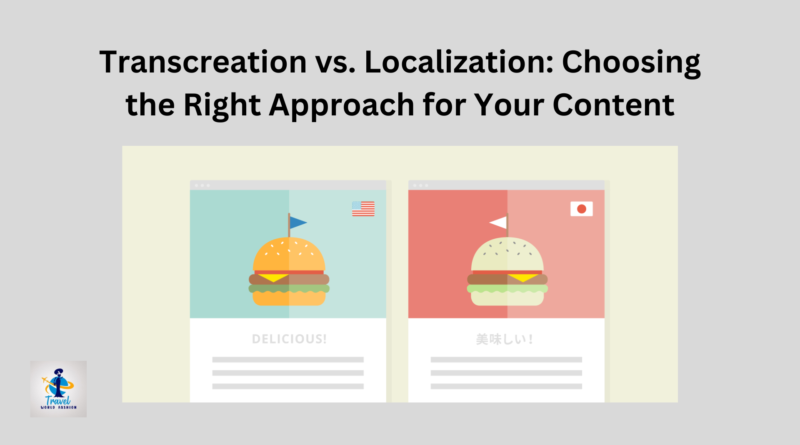Transcreation vs. Localization: Choosing the Right Approach for Your Content
Imagine this scenario: You’ve just created a brilliant piece of content that resonates with your audience in one country.
Now you want to expand your reach and connect with a new audience in another country.
However, you soon realize that simply translating the content doesn’t do justice to the nuances of language and culture in the new market. This is where transcreation and localization come into play.
So, what exactly is the difference between transcreation and localization? How do you decide which approach to use for your content? In this article, we’ll delve into the world of transcreation and localization and explore how to choose the right approach for your content.
Table of Contents
Transcreation: Bridging Emotional Connections
When it comes to transcreation, it’s all about capturing the emotional intent and message of the content, rather than focusing solely on words.
Transcreation goes beyond translation, using creative adaptions and cultural insights to bring the content to life in a new language and context.
Breaking Language Barriers
One of the primary reasons to opt for transcreation is to bridge the gap between languages, allowing for a seamless emotional connection with the target audience.
By recreating the tone, style, and message of the original content, transcreation helps to evoke the same emotional response in the new audience.
For example, let’s say a skincare brand creates a compelling advertisement in the UK featuring a witty play on words that appeals to the local audience.
When transcreating this content for the Singapore market, the focus would be on recreating the emotional impact rather than directly translating the pun.
This could involve incorporating local cultural references or adapting the language to match the local lingo, making the content relatable and engaging for the target audience.
Cultural Relevance and Nuances
Transcreation takes into account cultural differences, customs, and preferences to ensure the content is culturally relevant and resonates with the target audience.
It considers the context in which the content will be consumed and tailors it accordingly.
For instance, the best Transcreation services agency promoting a holiday package in the UK may use images of a white sandy beach with blue skies to entice their audience.
However, in Singapore, where tropical beaches are a common sight, the same imagery may not have the same impact.
Transcreation would involve replacing the images with something more culturally relevant, such as iconic local attractions or food, to establish a stronger connection with the Singaporean audience.
Enhanced Creativity and Impact
Transcreation allows for greater creativity and flexibility compared to localization.
It provides an opportunity to adapt the content in a way that captures the essence of the original while making it more impactful and relatable to the target audience.
This can involve incorporating local humor, wordplay, or idiomatic expressions that resonate with the culture or language of the new market.
Localization: Adapting to Cultural Norms
While transcreation focuses on recreating the emotional intent of the content, localization emphasizes adapting the content to align with the cultural norms, values, and preferences of the target market. It goes beyond language and delves into the cultural context of the audience.
Cultural Appropriateness
Localization involves tailoring the content to ensure it aligns with the cultural sensitivities and customs of the target market.
This is particularly important in countries like Singapore, where people come from diverse cultural backgrounds.
Adapting the content to suit these cultural norms ensures it is well-received and resonates with the local audience.
For example, a fast-food chain may need to adapt its menu options and ingredients to cater to the dietary preferences and restrictions of the Singaporean market.
Localization would involve offering vegetarian or halal options consistent with the local food preferences and religious practices, thus making the content more culturally appropriate.
Adhering to Local Regulations
Localization also takes into account local regulations and standards.
This is especially relevant when dealing with legal, financial, or healthcare content, where adherence to local laws and guidelines is crucial.
By ensuring compliance with local regulations, businesses can avoid potential issues or miscommunications that may arise when content is not adapted to meet local requirements.
For instance, in the financial sector, companies must adapt their content to reflect the regulations set forth by the Monetary Authority of Singapore (MAS).
This could involve rewording disclaimers or including specific legal information specific to the local market.
User Experience and Adaptation
Localization focuses on providing a seamless user experience by adapting the content to suit local preferences in terms of design, layout, currency, and measurements.
By making these adjustments, businesses can ensure a more familiar and user-friendly experience for the audience.
For instance, an e-commerce platform expanding into the Singapore market would need to adapt its site to display prices in SGD, use local imagery, and incorporate local payment options like PayNow or GrabPay to provide a familiar and convenient user experience.
Finding the Right Balance
When it comes to deciding between transcreation and localization, it’s essential to consider the specific requirements of your content, target audience, and communication objectives.
Both approaches have their merits and can be used in combination to achieve the desired impact.
For instance, a marketing campaign for a multinational brand may opt for transcreation to capture the emotional appeal of the brand’s messaging, while using localization to ensure the content is culturally relevant and resonates with each target market.
It is important to keep branching articles open to different perspectives, so as to cover the length sufficiently. Also as soon as you select the right modes of contenting, you can aptly target the culture as your target audience.
Personal Perspective
As a content creator myself, I’ve had the opportunity to work on projects that required both transcreation and localization.
Each approach brought its unique challenges and rewards. For example, while transcreation allowed me to think outside the box and incorporate cultural elements to make the content truly resonate with the target audience, localization forced me to pay attention to the smallest details and adapt the content to align with the cultural nuances of the local market.
I believe that both approaches have their place in the world of content creation, and the key lies in understanding your audience and the purpose of your content.
With the right blend of transcreation and localization, businesses can foster meaningful connections and drive positive engagement with their target markets.
Conclusion
In today’s interconnected world, reaching diverse markets requires careful consideration of language, culture, and audience preferences.
Transcreation and localization are two powerful tools that can help bridge the gap between content and its target audience.
By understanding the essence of each approach and considering the specific requirements of your content, you can choose the right strategy that aligns with your communication objectives and resonates with your target audience.
For more fashion and travel tips visit Travel World Fashion.




